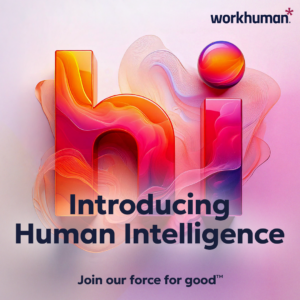
How AI-Powered Background Checks Supercharged Our Hiring Process
Sponsored by Checkr. My talent team uses AI and automations every day, in almost every workflow. Yes, we’re a tech company (so AI is basically

Sponsored by Checkr. My talent team uses AI and automations every day, in almost every workflow. Yes, we’re a tech company (so AI is basically

Sponsored by Checkr. Hiring is about far more than filling roles. It’s about forging connections with talent that can build a viable pipeline and lead

Sponsored by Fama. Walk into any workplace today and chances are the majority of your team grew up online. Digital natives—people who’ve never known life

If you’re a leader in HR Tech, you want to be known for your expertise and your perspective. That’s how you build trust in your

Day One musings from Workhuman Live 2025 in Colorado, weighing in on the power of live events to wake us up and make us love

A CEO’s perspective on building high-performing, future-ready organizations. Sponsored by Betterworks. At our recent event, EmpowerHR 2025, I had the privilege of being surrounded by

Sponsored by Betterworks. The role of HR is changing faster than ever. As someone who’s spent over two decades in this field, I can confidently

Sponsored by Workhuman. In today’s rapidly evolving workplace, upskilling isn’t just an advantage — it’s a necessity. Employees who learn new skills are more engaged,

Sponsored by SAP Concur In the past 12 months, more than 30 million flights have been booked in Concur Travel. Although every organization has its

I’m just going to come out and say it: the SAP SuccessConnect 2024 (October 28-30) was a blast. Why? For one thing it reminded me

Sponsored by Culture Amp How important is culture to your organization right now? As people and culture leaders, you know that putting time, effort, and

Sponsored by ExecOnline Today’s leaders face mounting and unprecedented changes in nearly every aspect of their roles. From managing a hybrid workforce to adopting new

Sponsored by Fama Technologies We have likely all had the experience of a bad hire. For some of us, horror stories come to mind. Finding

Sponsored by ExecOnline In today’s fast-paced business landscape, companies are contending with frequent organizational shakeups brought on by ever-changing economic conditions, market shifts, and the

Sponsored by Culture Amp Creating a business case for culture is a priority for senior HR leaders, CHROs, and CPOs. It’s especially true in these

Sponsored by Firstup. We’ve all encountered employee onboarding nightmares. Perhaps your manager forgot your start date. Or maybe the tools and technology assigned to you didn’t

Sponsored by Firstup For years, Gallup has tracked global employee engagement. Although the trend line has improved somewhat over the past decade, still only 23% of

If you follow tech industry news, you’re no doubt aware of ongoing layoffs at Google. Early this year, a New York Times reporter asked me

Sponsored by The Culture Platform “Get some perspective.” That’s the best advice I ever received as a manager. And I took it to heart, because during

As we take our first steps into 2024, it’s hard to imagine what this year will bring for HR and L&D. Last year was tumultuous,

In less than 20 years, podcasting has revolutionized the way we consume and engage with informational content, offering a powerful digital platform for individuals to

Sponsored by The Culture Platform What tools actually help managers manage their people? That’s the most important question every organization needs to ask itself as the

Sponsored by ADP The WOTC (Work Opportunity Tax Credit) offers businesses a tremendous opportunity for tax credits based on hiring. But for organizations to participate

Sponsored by: Neocase Did you know more than 160 million people are employed in the U.S.? Unfortunately, however, rising turnover is eroding workforce retention. In

2021 turned out to be a year that introduced many new terms into the common vocabulary. One of the most popular terms – The Great